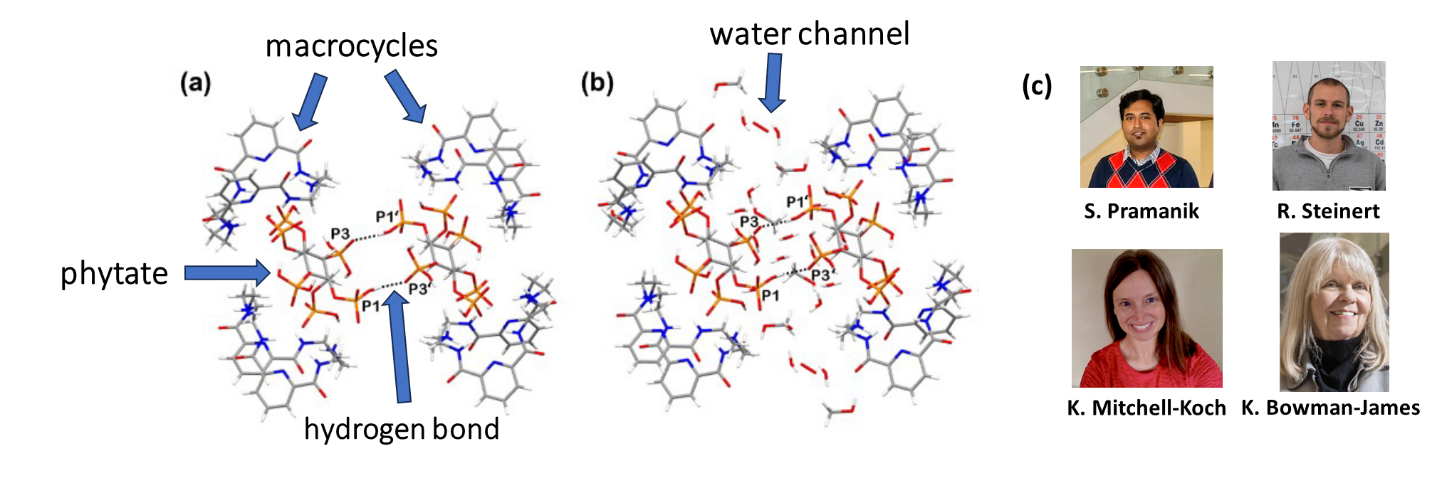Prof. Kristin Bowman-James named September 2023 Sutton Family Research Impact Award recipient

The Department of Chemistry congratulates Professor Kristin Bowman-James on receiving the September 2023 Sutton Family Research Impact Award!
The Sutton Award is a monthly competition among chemistry faculty. Every month, the Chemistry Department Chair and Associate Chairs review the peer-reviewed papers published by chemistry faculty from the three previous months to select a winner. The recipient receives a $500 cash prize and is featured on the departmental website.
For a full list of winners, visit our Sutton Family Research Impact Award webpage.
Structural Insight on Supramolecular Polyion Salts: Inositol Hexaphosphate Enclosed in Cationic Macrocyclic Clusters
By Subhamay Pramanik, Ryan M. Steinert, Katie R. Mitchell-Koch, and Kristin Bowman-James
Published in Chem. Eur. J. 2023, 29, e20230174
Phosphorus is an essential element in the chemical balance of all living organisms. It comprises a major component of the building blocks of life, i.e., DNA and RNA, and plays major roles in life processes. An important example is its role in agriculture, where it is involved in plant growth and seed maturation, as well as the fertilizers used to maintain plant health. An organic molecule containing six phosphates and known as phytate is one of the critical species involved in many of these processes. Scientists worldwide are very interested in understanding how this molecule works. They are especially curious about the interactions of its six negatively charged phosphates, which are tied relatively close together by virtue of phytate’s small organic framework. In this paper our group used a macrocycle, a cyclic organic molecule, to explore the possibility of trapping phytate in solution to find out more about its structure and interactions with water as well as with neighboring phytate ions.
We also collaborated with Katie Mitchell-Koch, a professor at Wichita State University, who received her Ph.D. degree in theoretical chemistry at KU with Professor Ward Thompson. Our group used nuclear magnetic resonance for solution studies and then determined the crystal structure of the interactions between phytate and our macrocycle using X-ray crystallography. Dr. Mitchell-Koch then used Density Functional Theory (DFT) to examine how our crystal structure might relate to the actual solution structure.
Our results indicated that each of the phytates had a -6 negative charge and each of the macrocycles had a +3 charge, so two macrocycles and one phytate gave a neutral sandwich-like structure. Each sandwich was observed to interact with a neighboring sandwich, resulting in a cluster of four macrocycles and two phytates. The clusters were held together by the two phytates, which interacted with each other through hydrogen bonding. This means hydrogens from one phosphate were close enough with the adjacent phytate to interact with one of the nearby phytate’s oxygen atoms (denoted by the dotted lines in the Figure, structure (a)). These interactions were what held the clusters together, but which still allowed for channels for the water molecules, shown in the Figure, structure (b). Dr. Mitchell-Koch’s theoretical findings confirmed our results, and also indicated that the hydrogens on the phosphates in both of the phytate ions were quite labile, and could readily move from one phosphate to another. These findings are important since they show the hydrogen interactions between adjacent phytates, the mobility of the hydrogens within each phytate ion, plus the channel-like water networks. Such interactions could also help to understand phytate’s roles in biological systems where, instead of the macrocycles, phytate ions interact with enzymes and other biomolecules.

Figure. (a) Cluster of four macrocycles and two phytates without the solvent molecules (water and a few methanols) and (b) the same cluster with the water and methanol molecules added. In the stick diagram the atoms are shown with different colors: hydrogens are white; carbons are gray, nitrogens are blue; and most importantly, the phosphates are dark yellow (phosphorus) and red (oxygen). (c) Snapshots of the authors.